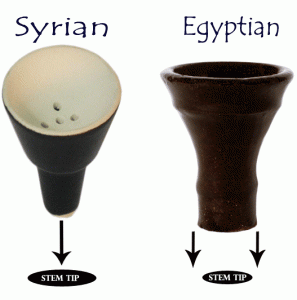The modern hookah pipe has gone through many forms and variations over the centuries. One of the biggest determining factors in design has to do with the region of origin.
Believe it or not, the difference isn’t where they’re made. Syrian hookahs can be made in Egypt, and Egyptian hookahs in Syria; both can be produced in China… you get the idea. With the increasing popularity of hookahs, these two different styles are becoming almost indistinguishable; they used to be more distinct in subtle ways.

Traditionally, one of the distinguishing factors was the type of bowl used. Syrian hookahs were once constructed primarily to accept inside-fitting (or male) bowls, while Egyptian hookahs were constructed for outside-fitting bowls (or female). If you don’t get the ‘male’ ‘female’ distinction, then let’s meet up after gym class and I’ll draw you a diagram.
What this meant was that that the juice from your tobacco would run on the outside of Egyptian hookahs (which doesn’t look that great) and the inside of Syrians (which means more frequent cleaning).
Syrian hookahs gradually shifted to accommodate the increasing variety of bowls and accessories designed in the female style. This left the main identifying feature of Syrian hookahs to be their more detailed ornamentation.
As far as the stems go, Egyptian stems utilize brass, copper, and stainless steel; sometimes all 3 as seen on the Khalil Mamoon Tri-Metal.
Syrian stems are usually entirely made of brass or stainless steel without any mixing, though they are at times coated in nickel to give them a silver sheen. The pieces are welded together by hand after they’ve been etched, adding a touch of finesse to them.
Recently, more Egyptian hookah companies have been making all-brass hookahs, so it is no longer just a Syrian feature.
Generally, the Egyptian hookah shafts are turned on a lathe, whereas many Syrian hookahs are cast. These Syrian hookahs feature an inner brass tube (through which the smoke passes) surrounded by metal of varying compositions that is cast, unlike the lathed Egyptian shafts.
All history aside, both of these hookahs provide very similar smoke experiences and are looking more and more alike. It seems that the only real difference comes when you’re talking to someone from Syria or Egypt, then it becomes a matter of country pride!
